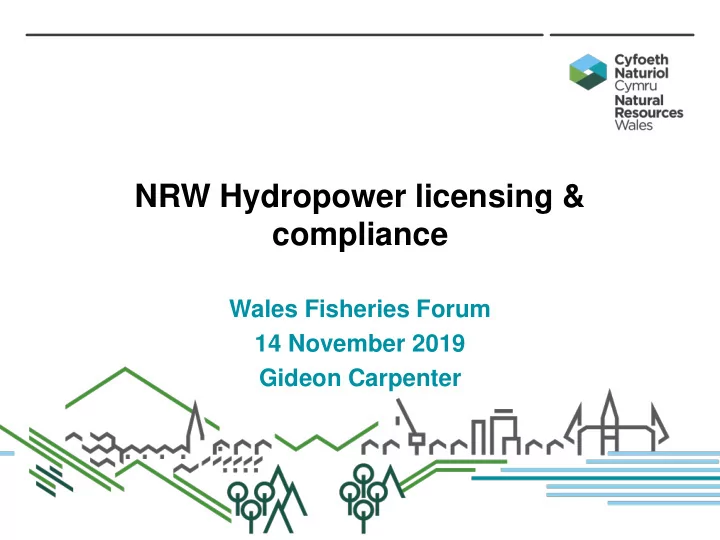

NRW Hydropower licensing & compliance Wales Fisheries Forum 14 November 2019 Gideon Carpenter
Licensing background • Water resources regulation established in England and Wales with Water Resources Act 1963 • Water Resources Act 1991 (as amended) • Most hydropower schemes will require an: Impoundment Licence Abstraction Licence
Licensing background • Focus on big hydro • Financing in 1990’s – limited expansion of run-of-river hydro (RoR) • Limited National Rivers Authority/ EA guidance • Feed-in-Tariffs 2010 – rapid expansion of RoR • EA guidance focused on low head – N Wales flow variability • Good Practice Guidelines review • NRW establishment – NRW HEP guidance 2014 • Water Framework Directive & WG Environment Bill
Run of river hydropower schematic
Run of river high head
So what are the main impacts? • Changes to reach hydrology - Creation of impoundment - Creation of depleted reach - Changes to hydraulic conditions (depths, velocities, wetted perimeter) (hydrological barrier) • Creation of physical barrier - Disruption of ecosystem connectivity (inc fish migration) - Disruption of geomorphological processes • Changes to physical habitat & channel morphology • Physical damage to fish (& other wildlife)
How do we address these? Abstraction and impoundment licensing NRW abstraction regimes Low impact siting & design for hydropower principles for intake structures • Geomorphology • Fisheries Compliance inspections and enforcement
Low impact abstraction regime • NRW Guidance - introducing the flow split • Zones 1, 2 & 3 – 10%, 40%, 50% and 70% take • Maintains flow variability in the low/medium flow range • Important for ecology and geomorphological processes • Influences spatial distribution of schemes • Protects our high value sites for nature conservation
Ecological Limits to Hydrological Alteration Uncertainty in quantifying river flow-ecology relationships BUT Ecosystems adapted to natural flow regimes Restrict deviations from the natural flow regime Ecological Limits to Hydrological Alteration (ELOHA)
Impacts of hydrological change - conceptual model Flow – ‘the master variable’ Flow – ‘the master variable’ Hydrology Impacts Impacts species Biological Habitat Hydraulics & ecosystem processes state level population level Geomorphology Source: Ecological indicators of the effects of abstraction and flow regulation and optimisation of flow release from water storage reservoirs WFD 21d SNIFFER 2012
Example of indicators of hydrological alteration 500% Frequency Natural flow 450% Residual flow 400% 350% Flow as % mean flow 300% 250% Magnitude 200% Duration Quantifying of 150% deviation 100% 50% 0% Timing Date
Components of abstraction regime • Low flow protection (Hands off Flow) – fixed flow rate • Flow variability – fixed % take of available flow • Maximum abstraction rate – intake and conveyance capacity limits Fixed dimensions Licence conditions in hydraulic design
Scheme for licensing non consumptive abstractions (including hydropower) No depleted reach Schemes creating a depleted reach On-weir schemes Indicative Mitigation Standards Zone 1 Zone 2 Zone 3 Designated sites, Depleted reach gradient Depleted reach gradient Tier 1 <10% >10% supporting habitats and Lower catchment rivers Upper catchment streams protected species. and streams Abstraction of up to 10 to 40% take 50% take 70% take 100% of available flow Max abs = 1.3 x Q mean Max abs = 1.3 x Q mean Max abs = Q mean above Hands off Flow Low flow protection = Low flow protection = Low flow protection = minimum of Q 95 minimum of Q 95 minimum of Q 95 Environmental survey and impact assessment . Site specific mitigation Also see guidance on zone movement for site characteristics and gradient Tier 2 Zone 1 Zone 2 Zone 3 Mitigation standards Mitigation standards Mitigation standards
Plot showing hydropower abstractions as a percentage of total river flows against flow percentiles under a range of abstraction regimes using small upland catchment flow data (Hepste at Esgair Carnau). 1.600 100 90 1.400 80 1.200 70 % of natural river flow 1.000 60 Flow m3/s 0.800 50 40 0.600 30 0.400 20 0.200 10 0.000 0 Q0.1 Q2 Q4 Q6 Q8 Q10 Q12 Q14 Q16 Q18 Q20 Q22 Q24 Q26 Q28 Q30 Q32 Q34 Q36 Q38 Q40 Q42 Q44 Q46 Q48 Q50 Q52 Q54 Q56 Q58 Q60 Q62 Q64 Q66 Q68 Q70 Q72 Q74 Q76 Q78 Q80 Q82 Q84 Q86 Q88 Q90 Q92 Q94 Q96 Q98 Q99.9 Flow percentile Natural Flow (m3/s) Max abs Qmean 70% take Max abs 1.3 x Qmean 40% take Max abs 1.3 x Qmean 50% take UKTAG Mod Revised
Key issues
Physical barrier
Low impact siting and design principles • WFD – consider hydro-morphological response • Consider geomorphological setting of any structure location – ‘ siting ’ • Work with nature - replicate / mimic natural features
Low impact siting and design principles • Design to minimise disruption of natural geomorphological processes • Minimise structure size and associated works • Upstream and downstream fish passage – ‘nature - like’ easement – design principles • Intake screening • Plunge pools
Fish passage Fish passage easement for resident brown trout • Fish passage easement
Generic design
Generic design
Eel passage – boss type
Compliance challenges • Intake structures not built to approved design (WR & T&C Planning) • Intake structures built to approved design but subsequently modified (temporary or permanent) • Intake structures built to approved design but poorly maintained • Compliance focus moving forward • Inspections - Enforcement and prosecutions policy • Work with regulatory partners
In summary • NRW flow standards – flow variability • Spatial aspect of HEP development • Protects our high value sites for nature conservation • WFD & Env Act – geomorphology and ecological continuity – ‘ecosystems approach’ • Focus on low impact siting & design • Hiatus in financial support – no new licence applications • Guidance review • Ongoing compliance activities
Recommend
More recommend